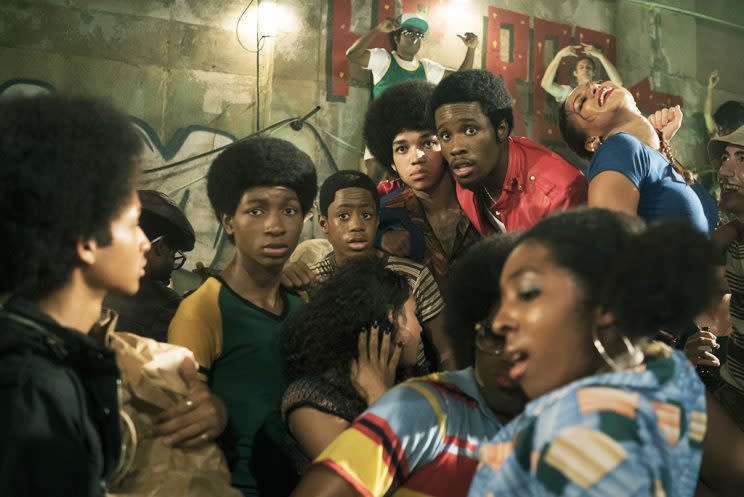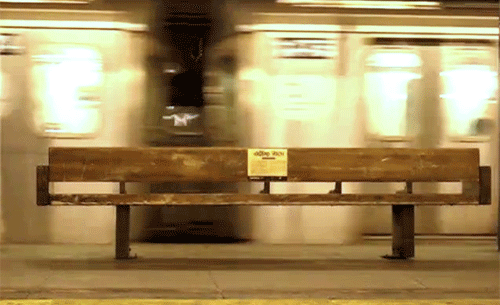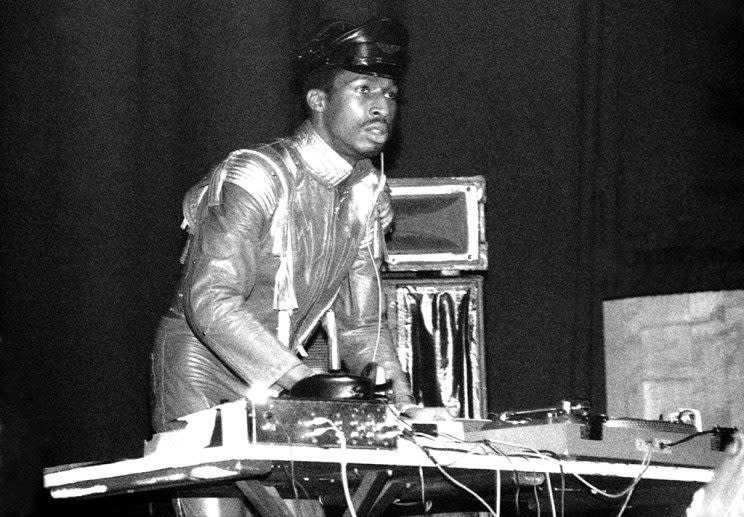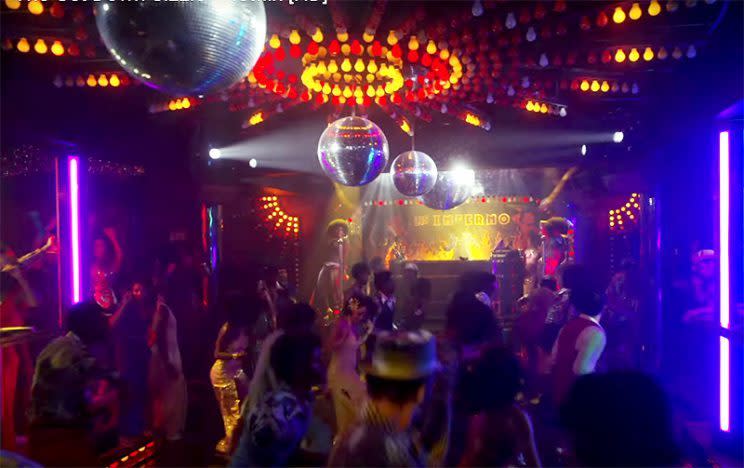'The Get Down': Tour the Boogie-Down Bronx With Producer Nelson George

Present day New Yorkers likely won’t recognize the version of the Bronx that burns with fiery energy (as well as actual fires) in Baz Luhrmann’s new Netflix series, The Get Down. Set in 1977, the series captures a period in the borough’s history when the Bronx embodied everything that people perceived to be wrong with New York. Racial tensions were high, crime was rampant, dilapidated buildings spanned every block and subway cars rattled by on elevated tracks covered stem to stern in multi-colored graffiti tags. From a distance, the Bronx represented urban decay at its most extreme. But as The Get Down depicts, within those neighborhoods and communities, young people still lived, loved and reached towards fulfilling lives, expressing themselves through emerging art forms like graffiti and hip-hop.
And author Nelson George witnessed their efforts firsthand. A lifelong Brooklyn resident, George was a frequent visitor to the Bronx in the ‘70s and ‘80s as a music journalist for such publications as Record World and Billboard. During that time, he saw hip-hop pioneers like Kool Herc and Grandmaster Flash spin their records onstage, and chronicled the seismic impact the resulting beats had on crowds both in the four boroughs and beyond.
His experience is fully brought to bear in The Get Down, for which he serves as a producer alongside Grandmaster Flash. “It’s kind of a beautiful sense of déjà vu, seeing these actors who were your age when you were experiencing this for the first time,” George tells Yahoo TV. “Watching them learning these dances, and learning the walks; there’s something about watching younger people do it that gives it a sense of possibility. It made it very fresh again, which makes The Get Down feel like less a vintage show, and more like something happening now.”

Because the Bronx has been transformed by the same wave of commercial and residential development that has swept across New York in the past decade, the series couldn’t create the area’s past entirely on location. Still, they used actual Bronx settings whenever possible; George estimates that roughly 50 percent of the series was filmed on location, while the bulk of the rest was shot on sound stages in a converted factory in Queens. “The areas of the Bronx that everyone has in their minds [from the ‘70s] look completely different now,” he says. “It’s really kind of a lovely section of the city. There’s a lot of development and there’s a lot of pride. The Bronx is on the upswing and we’re going to be part of that.”
To see just how much the Bronx has changed between the era of The Get Down and the present, hop on an uptown subway and take the following guided tour programmed and narrated by George and featuring six significant locations from hip-hop history that have been incorporated into the series. Ladies and gentlemen, the Bronx is waiting.

(Credit: Vimeo)
The Writer’s Bench (149th Street and Grand Concourse Subway Station)
Start your tour when you disembark at this centrally-located subway station, which houses a bench where ‘70s graffiti artists would congregate to share books and tagging advice. An early scene in The Get Down’s pilot episode depicts a youthful tagger (played by Jaden Smith) hanging out with other like-minded artisans.
Today it’s just a bench in a subway station. You’re not going to see any ‘70s-style graffiti there. It’s not something that New York City and the Transit Authority want to celebrate. That was a very contentious era in New York City, and the authorities were never fans of graffiti. So they’ve never made it a major [tourist] destination. But tourists from all over the world do go there! It’s a place that everyone who is into that culture knows about, and they go there to pay homage.

While we were making the series, the kids met with a number of famous graffiti artists like Lady Pink, who is one of the most famous female taggers. And Daze and Crash are actually talking to Jaden in one scene, and were advisors on the show. All the cast got hands-on instruction; one day, they went out at had graffiti lessons, getting specific training to make it look realistic.

Andrew Freedman Home (1125 Grand Concourse)
Head up the boulevard-wide Grand Concourse to this historic location, the construction of which was posthumously funded by the eponymous millionaire. Opening its doors in 1924, the Home was a retirement community for much of its history. It was granted Landmark status in 1993, and today serves as both a residence and art space.
The original history of the Freedman is that it was a place for [retirees]. Over time, like many things in the Bronx, it fell into disrepair. During the time the show takes place, my impression is that it wasn’t fully open to the public. But then it was repurposed as a community center and residence, and one of its long term residents is Kool Herc. He lives there as do a number of other Bronx artists. On the Grand Concourse side of the building, there’s a wall with a giant mural of Kool Herc, so anybody who goes there can take pictures in front of it. There are community activities there, but no big performances. Baz actually had some of our writing sessions at the Freedman, and we also shot a lot of scenes inside the house, as well as on the roof.

1520 Sedgwick Avenue at 181th Street
Don’t let the unassuming exterior fool you; this apartment building is an even more important historical landmark than the Freedman Home. On August 11, 1973, a young Kool Herc hosted a get together in the building’s rec room that is widely considered to be the world’s first hip-hop party. Herc’s hangouts quickly became must-attend affairs for the borough’s teenage population, and no special invitation was required.
Those parties were aimed at young people in the community. It very much had a local rec center vibe. Herc’s parents would have been there, selling hot dogs or whatever. It was very much open to the public, especially kids. The whole idea was to get kids off the streets, and as Herc got more famous it became a little bit more of a social thing. The address is internationally famous; tourists from all over the world go by and take pictures in front of it. There are T-shirts you can find with that address on it. At this point, there isn’t a plaque or anything, but I think eventually there will be. People still live there — it’s a residence.

We literally rebuilt that room in an upcoming episode. The production team met with Herc and were very specific about what the place looked like then. We shot the exterior in front of the actual building, and then built a set for the inside. At that point in the show’s timeline, Herc would have been doing these parties for about four years by the time our characters end up there. It was a big deal for us to be able to go back to the original site of where hip-hop as we know it was created.

The Disco Fever (Jerome Ave. and 167th Street)
A Nexus point for the burgeoning hip-hop community, this club holds a storied place in music history, and is still spoken of (and written about) in hushed tones to this day. The 1985 film, Krush Groove, filmed several scenes at Disco Fever, which closed its doors the following year.
The Disco Fever didn’t start out as a hip-hop spot, but became that over time. I went there a number of times, and there was always a feeling of danger in there quite honestly. It had this clubhouse vibe. You’d go in and there’d be this big main room, and then you’d go up these staircases to the second floor. The further you went back, every room got smokier and smokier with people smoking cigarettes, herb and angel dust. You’d go into those dark rooms and you’d see everybody who was anybody in hip-hop at that time. It was a really amazing site in that way. Even at the time, it had this historic feeling. All sorts of artists did their first shows in New York there. In our show, the building that houses Kipling’s barber shop is inspired by the exterior of Disco Fever.

Club 371 (371 East. 166th Street)
One of the major locations in The Get Down is a disco club called Les Inferno, which was modeled after this real-world disco joint.
The discos that I went to in those days were the black adult discos that had mirror balls and people who were very much dressed up. There was a sense of trying to be sophisticated on some level. By doing the hustle and wearing these clothes, we were elevating ourselves somehow. There was definitely a sense of upward mobility embodied there. You’ve got to remember that the kids in the show are teenagers, so to get into these disco clubs, you had to be of age to get in.
Whereas hip-hop was an outdoor kid thing, where you could wear sneakers and shorts. Hip-hop and disco were very different, and stayed disconnected from each other well into the ‘80s. Club 371 doesn’t have an especially long history, because it was a pretty volatile time and was controlled by drug dealers, as the show depicts. So it was very popular for awhile, and then there was a whole era where people were getting robbed and so forth. But when it was around, it was very popular. DJs from Harlem to Hollywood would come play there.

(Photo by Andrew Renneisen/Getty Images)
St. Mary’s Park (450 St. Ann’s Ave.)
Finish your tour at this 35-acre public park, which boasts baseball fields, playgrounds, a recreation center and climbing rocks.
St. Mary’s was a hang-out spot back in the ‘70s. It was where people would go when they snuck away from school. There’d be parties or kids would bring their boom boxes, and play music and dance. It was an organic kind of outdoor space. We knew that the rocks in particular were pretty iconic. That’s why we made it a central location for the show.

In the pilot, Shameik Moore [who plays the kung fu-obsessed graffiti artist/DJ Shaolin Fantastic] slides down the rocks and tags them at the same time. That was really him sliding down, he did it three times in a row, perfectly. If you were a kid in New York in that era, kung fu was a huge part of your life. So Shaolin Fantastic embodies that dynamic, and Baz decided to really enhance it. That’s a big attraction of the show to me: we take the reality of what the Bronx was and push it, to give it a mythic quality.
The Get Down premieres Aug. 12 on Netflix

